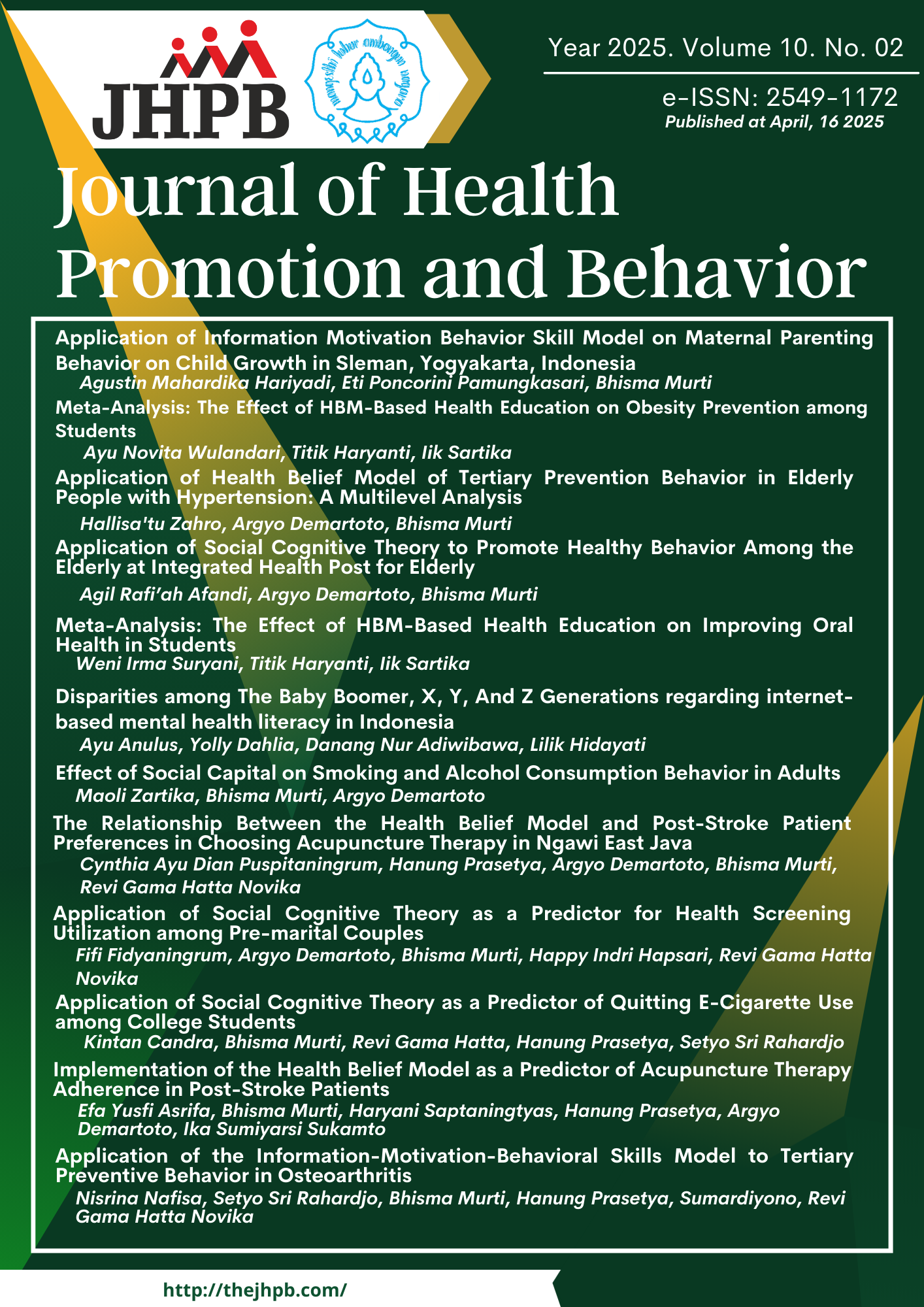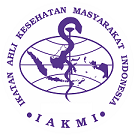Application of Social Cognitive Theory as a Predictor for Health Screening Utilization among Pre-Marital Couples
DOI:
https://doi.org/10.26911/thejhpb.2025.10.02.09Abstract
Background: Circumstances in the early stages of development have a tremendous impact on a person's risk of developing diseases in adulthood. Numerous diseases can start in childhood and are generated by various traumas in early life, including improper treatment during pregnancy, maternal malnutrition, and maternal disease, one of which is diseases related to reproductive health. Premarital health screening is a series of tests that must be carried out by prospective brides and grooms before marriage, which aims to reduce the burden of inherited diseases by reducing the number of high-risk marriages. This study aimed to analyze the use of health screening among pre-marital couples through the Social Cognitive Theory.
Subjects and Method: A cross-sectional study was conducted in Nias, Indonesia, in October-November 2024. A sample of 200 brides and grooms was selected using fixed disease sampling. The data were collected using questionnaire and analyzed using a path analysis.
Results: Outcome expectation was positively and indirectly associated with pre-marital health screening (b= 0.58; 95% CI= 0.01 to 1.15; p= 0.046). Knowledge, reinforcement, and observational learning were indirectly associated with pre-marital health screening among pre-marital couples.
Conclusion: Social cognitive theory can be used to predict health screening uptake among pre-marital couples.
Keywords:
health screening, pre-marital couple, social cognitive theoryHow to Cite
References
Adibsereshki N, Abkenar SJ, Ashoori M, Mirzamani M (2015). The effective-ness of using reinforcements in the classroom on the academic achieve-ment of students with intellectual disabilities. J Intellect Disabil. 19(1): 83–93. https://doi.or g/10.1177/1744-629514559313
Arlinghaus KR, Johnston CA (2018). Advo-cating for behavior change with edu-cation. Am J Lifestyle Med. 12(2): 113–116. https://doi.org/10.1177/155-9827617745479
Bener A, Al‑Mulla M, Clarke A (2019). Pre-marital screening and genetic coun-seling program: studies from an endo gamous population. Int J App Bas Med Res. 9(1): 20–26. http-s://doi.-org/10.4103/ijabmr.IJABMR_42_18
Delatycki MB, Alkuraya F, Archibald A, Castellani C, Cornel M, Grody WW, Henneman L, et al. (2020). Inter-national perspectives on the impleme-ntation of reproductive carrier scree-ning. Prenatal Diagnosis, 40(3), 301–310. https://doi.org/10.1002/pd.5611
Fryling MJ, Johnston C, Hayes LJ. (2011). Understanding observational lear-ning: an interbehavioral approach. A-nal Verbal Behav. 27(1): 191–203. Ht-tps://doi.org/10.1007/bf03393102
Garland M, Halloway S, Assistant RN (2022). Adherence to physical activity in african american women. Nurs Res. 70(4): 239–247. https://doi.org/1-0.1097/NNR.0000000000000516.Self-Efficacy.
Geerling R, Browne JL, Holmes-Truscott, Furler J, Speight J, Mosely K (2019). Positive reinforcement by general practitioners is associated with greater physical activity in adults with type 2 diabetes. BMJ Open Diabetes Res Care. 7(1): 1–10. https://doi.o-rg/10.1136/bmjdrc-2019-000701
Ghoreishi MS, Vahedian-shahroodi M, Jafari A, Tehranid H (2019). Self-care behaviors in patients with type 2 diabetes: Education intervention base on social cognitive theory. Diabetes and Metabolic Syndrome: Clin Res Rev. 13(3): 2049–2056. https://do-i.org/10.1016/j.dsx.2019.04.045
Govindaraju V. (2021). A review of social cognitive theory from the perspective of interpersonal communication. Multicultural Educ. 7(12): 488–492. https://doi.org/10.5281/zenodo-.5802235
Guo J, Wu J, He Q, Zhang M, Li H, Liu Y. (2022). The Potential Role of PPARs in the Fetal Origins of Adult Disease. Cells. 11(21): 1–25. https://doi.org/1-0.3390/cells11213474
Huttunen-Lenz M, Hansen S, Christensen P, Larsen TM, Sandø-Pedersen F, Drummen M, Adam TC (2018). PREVIEW study—Influence of a behavior modification intervention (PREMIT) in over 2300 people with pre-diabetes: Intention, self-efficacy and outcome expectancies during the early phase of a lifestyle intervention. Psychol Res Behav Manag. 11: 383–394. https://doi.org/10.2147/PRBM.-S160355
Kang W, Pineda Hernández S, Mei J (2021). Neural mechanisms of obser-vational learning: a neural working model. Front Hum Neurosci. 14-(April): 1–11. https://doi.org/10.338-9/fnhum.2020.609312
Kaveh MH, Montazer M, Karimi M, Hassanzadeh J (2022). Effects of a theory-based training program with follow-up home visits on self-manage ment behavior, glycemic in-dex, and quality of life among Iranian patients with type 2 diabetes mellitus. BMC Public Health. 22(1): 1–11. https:// doi.org/10.1186/s12889-022-13959-3
Morrison JD, Stuifbergen AK (2014). Out-come expectations and physical acti-vity in persons with longstanding multiple sclerosis. J Neurosci Nurs. 46(3): 171–179. https://doi.org/10.10-97/JNN.0000000000000050
Neherta M, Refnandes R (2023). Enam teori perubahan perilaku (R. Mach-mud (ed.); I). CV Adanu Abimata.
Reisi M, Mostafavi F, Javadzade H, Mahaki B, Tavassoli E, Sharifirad G. (2016). Impact of health literacy, self-efficacy, and outcome expectations on adhe-rence to self-care behaviors in irani-ans with type 2 diabetes. Oman Med J. 31(1): 52–59. https://doi.or g/10.-5001/omj.2016.10
Rostamian M, Kazemi A (2016). Rela tion-ship between observational lear ning and health belief with physical activity among adolescents girl in Isfahan, Iran. Iran J Nurs Midwifery Res. 601–604. https://doi.org/10.41 03/1735-9066.197681.
Kang W, Pineda Hernández S, Mei J (2021). Neural mechanisms of obser-vational learning: a neural working model. Front Hum Neurosci. 14: 1–11. https://doi.org/10.3 389/fnhum.202-0.609312
Schunk DH, DiBenedetto MK (2023). Learning from a social cognitive theory perspective. Int Encyclo Edu. 22–35. https://doi.org/10.1016/B97 8-0-12-818630-5.14004-7
Schunk DH, Usher EL. (2019). The Oxford handbook of human motivation (R. Ryan (Ed.); 2nd ed.). Oxford Univer-sity Press. https://doi.org /10.1093/-oxfordhb/9780190666453.001.0001
Scott HK, Jain A, Coogburn M (2023). Behavior modification. Treasure Is-land (FL): StatPearls Publishing. https://www.ncbi.nlm.nih.gov/books/NBK459285/
WHO (2013). Preconception care maxi-ming.Department of Maternal, New-born, Child and Adolescent Health. i–7.. https://iris.who.int/bits tream/ha-ndle/10665/340533/WHO-FWC-MCA-13.02-eng.pdf?sequence=1





